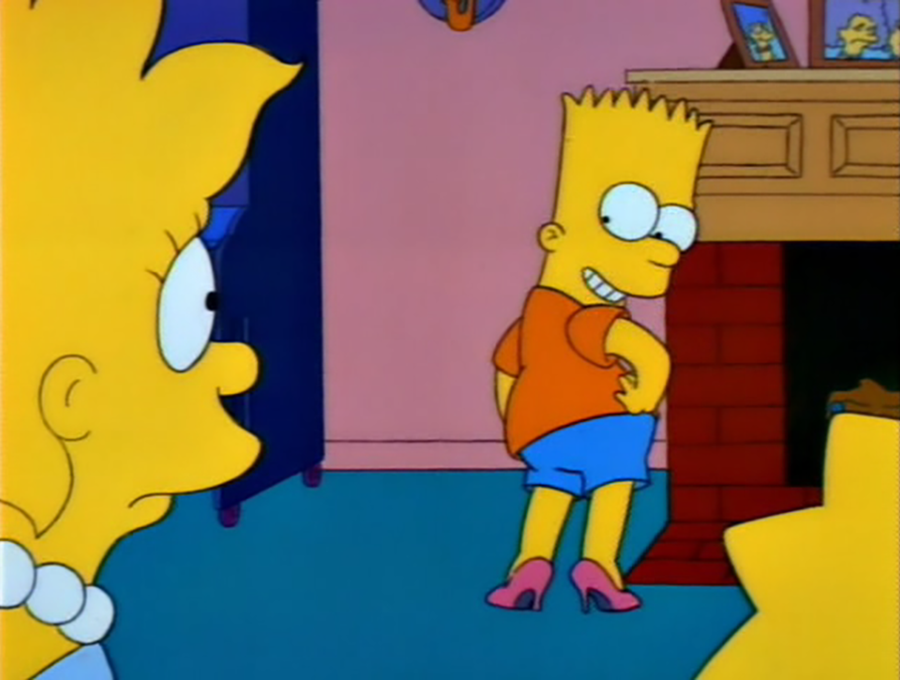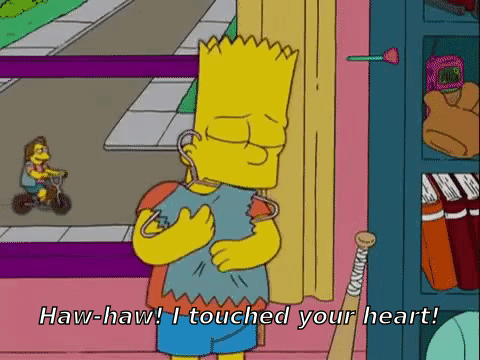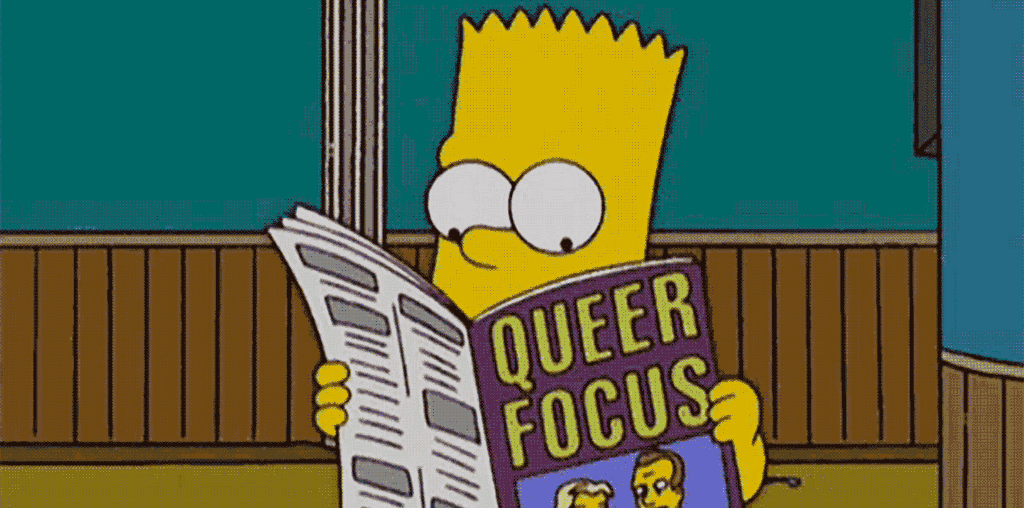I hate fan theories. Oh, sure, I can appreciate that with a certain kind of prestige TV show — your Stranger Things, your Westworld, your Orphan Black — viewers are propelled through the series by burning questions and outrageous twists that raise yet more burning questions. It’s just that when significant swaths of the internet are given over to people working to decode the grand designs of their entertainments, I’m tempted to argue they’ve spoiled the pleasures of passive watching.
Then again, I keep wondering about Bart Simpson’s sexual identity.
One of the curious side effects of The Simpsons’ maligned longevity — April will mark 30 years since the family’s debut on The Tracey Ullman Show — has been the near-subliminal continuity of a few motifs across those three decades, 10 show-runners and dozens of writers. There’s the continued refusal to specify which state the town of Springfield is in, Homer’s repeated false claims that some new ambition has been his “lifelong dream,” and Ned Flanders’ obscenely well-toned physique, to name but a few. And, perhaps, some hints about Bart’s sexual orientation, a characteristic that fascinates because it remains half-formed and necessarily ambiguous.

Every Simpsons fan recalls that in “Homer’s Phobia,” Homer suspects Bart is gay for a host of trivial reasons related to the influence of a family friend named John (voiced, in a timeless turn, by the national treasure John Waters): He starts wearing Hawaiian shirts, drops sassy phrases like “Homer, you are the living end,” and dances around the living room in a Hairspray-style wig.
That episode is rightly praised for its wry take on LGBT politics in the shifting landscape of the late ‘90s — it showed us how straights’ gay panic is not merely stupid, but rather passé, and easily overmatched by a little additional life experience. And, of course, the story is less focused on uncovering Bart’s “true sexuality” than on making a point about Homer’s ignorant prejudice: The kid is 10 years old and usually oblivious.
But do other episodes partly corroborate Homer’s assumption? Haven’t we seen frequent indications that Bart Simpson isn’t simply white-bread hetero, and instead complicated by a charming queerness? Indeed, some of Bart’s funniest moments involve him undermining his straight bad-boy persona. In season four, with Lisa reluctant to participate in a beauty pageant Homer has signed her up for, Bart teaches her how to walk in heels and even speculates he could win the contest. In the Rear Window parody “Bart of Darkness,” Lisa visits her secluded brother in his room — he’s broken his leg and been housebound for the summer — and is disturbed to find he’s writing a stuffy Victorian parlor drama in the vein of Oscar Wilde.
The strongest argument for Bart’s straightness is his string of dalliances with girls, yet these end up being neither evidence for or against a given reading of his sexual persona. They could just as easily represent the first fumbling advances of a hetero boy or the awkward liaisons of a kid who doesn’t realize that girls aren’t really his thing. In each case, the courtship seems motivated by Bart’s desire to show who he wants to become as opposed to who he wants to be with.
His first genuine crush (season 4, episode 8, “New Kid on the Block”) is on his older neighbor, Laura Powers, an unattainable tomboy he seeks to impress with put-on maturity, but in the end their dynamic resolves to that of mischievous siblings. Next, in season 6’s “Bart’s Girlfriend,” he goes after the Reverend Lovejoy’s daughter Jessica, whose attractiveness is tied up in her juvenile criminality — the two vandalize the town on their big date, and Bart waxes rhapsodic about the way she throws rolls of toilet paper. Love should entail being comfortably yourself in the other person’s presence, though here it serves as a pretext for Bart to indulge his worst instincts.
Much later on, in “The Bart Wants What It Wants” (season 13, episode 11) Bart dates Greta Wolfcastle, daughter of Schwarzeneggeresque action star Rainier Wolfcastle, apparently to access her plush lifestyle and famous dad, and finally blows her off for the opportunity to heckle Principal Skinner at a standup comedy open mic. This is callous even by Bart’s standards, and it reveals a shocking lack of interest in the opposite sex. He doesn’t for a moment regret the blasé decision to dump Greta until his best friend Milhouse happens to catch her on the rebound.
Speaking of Milhouse: I’d say that what he and Bart share is more than typical young male companionship. In “Bart’s Friend Falls in Love,” Milhouse is smitten with a transfer student named Samantha Stankey; Bart schemes not to steal the girl but to detonate the affair so he can have Milhouse back. Whatever discomfort Bart evinces at Milhouse’s emotional attachment to him takes the familiar, unsubtle form of denial. And when Bart does find friendship with another boy, it’s expressly coded as romantic: “The Haw-Hawed Couple” of season 18 sees him growing close to class bully Nelson Muntz, only to wind up fearing the intensity of his devotion. In the end, Bart wistfully cradles one of his denim vests — an allusion to Brokeback Mountain.

Weigh this tenderness against Bart’s first foray into the theater of hetero love: Season 3 finds him getting revenge on his lonely teacher, Mrs. Krabappel, by replying with ardor to a personal ad she placed in the paper. In a coldly calculated act of revenge, he makes her fall head over heels for letters from “Woodrow,” a fiction with the face of hockey legend Gordie Howe. That Bart gleans his material from pulpy old films on TV and Homer’s half-lewd, drunken postcards to Marge—that he has weaponized a performance of masculine heterosexuality—should not be lost on us.
Again, none of this is to suggest that the rotating crew of creatives behind The Simpsons has made a canonical choice about Bart’s path in life. He still hasn’t hit puberty, remember, and among the show’s pleasures is the way in which these matters are left open to interpretation. Which means my little fan theory isn’t as crucial as predictions regarding who’s going to die, and how, on Game of Thrones or The Walking Dead. It’s not as air-tight as the latest deductions about which spinoff superhero Marvel will monetize with a Netflix pilot in 2021. But it has been staring us in the face, and the more I rewatch my favorite classic episodes of The Simpsons, the more I see it through this lens.
Each time Bart is revealed to adore the scent of lilac, each time he enjoys a Gilbert and Sullivan operetta or revels in the put-downs of a catty red-carpet fashion critic, each time he lets slip a surprisingly effeminate phrase, we are allowed — if not encouraged! — to celebrate the possibility of a universe in which Bart is gay, bi, trans, queer, or something else entirely. Why couldn’t he be? And wouldn’t this theme neatly align with The Simpsons’ legacy of understated subversion? That we default to thinking of Bart as straight can only confirm our own boring bias. Try my theory on for size sometime — you just might find yourself convinced.

